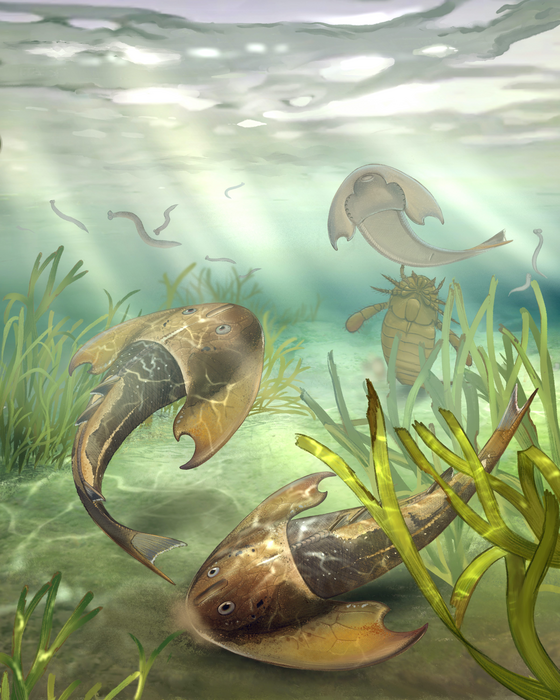A trove of fossils, unearthed in rock from China dating back some 436 million years, has revealed for the first time that the mysterious galeaspids, members of an extinct clade of jawless fish, possessed paired fins.

Credit: ZHENG Qiuyang
A trove of fossils, unearthed in rock from China dating back some 436 million years, has revealed for the first time that the mysterious galeaspids, members of an extinct clade of jawless fish, possessed paired fins.
The discovery, by an international team led by Prof. ZHU Min from the Institute of Vertebrate Palaeontology and Palaeoanthropology (IVPP) of the Chinese Academy of Sciences and Prof. Philip Donoghue from the University of Bristol, shows the primitive condition of paired fins before they separated into pectoral and pelvic fins, the forerunner of arms and legs.
The findings were published in Nature on Sept. 28.
Until now, the only surviving galeaspid fossils were heads, but these new fossils comprise whole bodies. They were found in rocks in Hunan Province and Chongqing and were named Tujiaaspis after the indigenous Tujia people who live in the region.
Theories abound about the evolutionary beginnings of vertebrate fins and limbs—the evolutionary precursors of arms and legs—and are mostly based on comparative embryology. There is a rich fossil record of early vertebrate , but they either had separated paired fins or they didn’t. There has been little evidence for the gradual evolution of fins.
According to first author GAI Zhikun, a professor at IVPP, “The anatomy of galeaspids has been something of a mystery since they were first discovered more than half a century ago. Tens of thousands of fossils are known from China and Vietnam, but almost all of them are just heads—nothing has been known about the rest of their bodies—until now.”
The new fossils are spectacular, preserving the whole body for the first time and revealing that these animals possessed paired fins that extended all the way from the back of the head to the very tip of the tail. This is a great surprise since scientists had thought galeaspids lack paired fins altogether.
“Tujiaaspis breathes new life into a century old hypothesis for the evolution of paired fins, through differentiation of pectoral (arms) and pelvic (legs) fins over evolutionary time from a continuous head-to-tail fin precursor,” said corresponding author Prof. Donoghue.
This “fin-fold” hypothesis has been very popular, but it has lacked any supporting evidence until now. The discovery of Tujiaaspis resurrects the fin-fold hypothesis and reconciles it with contemporary data on genetic control of the embryonic development of fins in living vertebrates.
Tujiaaspis shows the “primitive condition” for the evolution of paired fins, according to Prof. ZHU, who said that later jawless fish showed the first evidence for the separation of this fin-fold into pectoral and pelvic fins. Prof. ZHU also noted that the vestiges of elongate fin-folds could be seen in the embryos of living jawed fishes, which could be manipulated to produce them.
Bristol’s Dr. Humberto Ferron, a co-author, used computational engineering approaches to simulate the behaviour of models of Tujiaaspis with and without the paired fins. He said, “The paired fins of Tujiaaspis act as hydrofoils, passively generating lift for the fish without any muscular input from the fins themselves. The lateral fin-folds of Tujiaaspis allowed it to swim more efficiently.”
“Our new analyses suggest that the ancestor of jawed vertebrates likely possessed paired fin-folds, which became separated into pectoral and pelvic regions,” said co-author Dr. Joseph Keating from the University of Bristol.
He noted that the primitive fins evolved musculature and skeletal support that allowed our fish ancestor to better steer their swimming and add propulsion.
“It is amazing to think that the evolutionary innovations seen in Tujiaaspis underpin locomotion in animals as diverse as birds, whales, bats, and humans,” he said.
Journal
Nature
DOI
10.1038/s41586-022-04897-6
Article Title
Galeaspid anatomy and the origin of vertebrate paired appendages
Article Publication Date
28-Sep-2022




